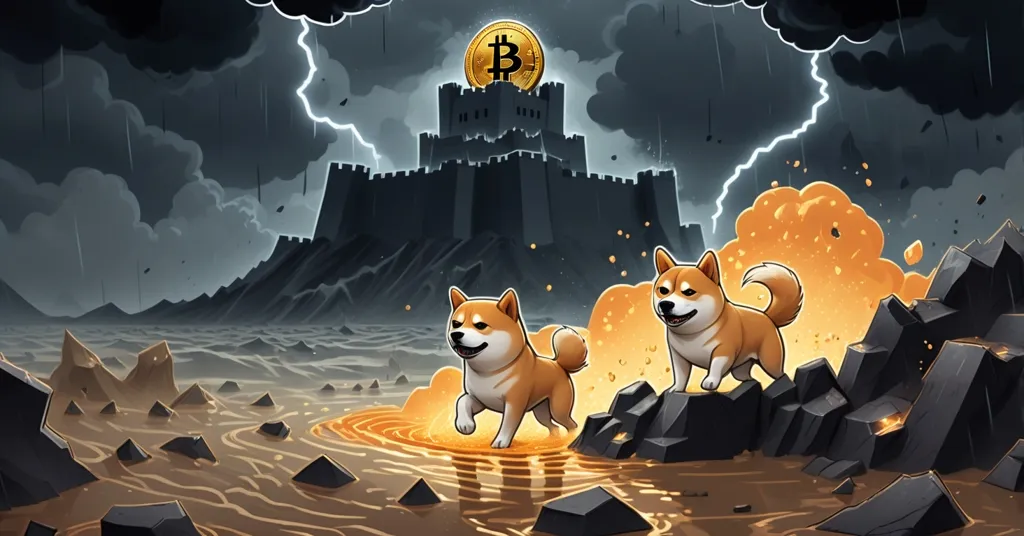Crypto Crash 2025: XRP Plummets, Bitcoin Slips, and Shiba Inu Shows Signs of Life

Crypto Market Carnage: XRP Crumbles, Bitcoin Falters, and Shiba Inu Flickers
Brace yourselves, crypto warriors—the market is dishing out a savage beating. Bitcoin (BTC) is sliding into dangerous territory, XRP is collapsing under its own weight, and Shiba Inu (SHIB) is sparking some curious activity amidst the bloodshed. Let’s slice through the hype and despair to analyze what’s driving this downturn, why it matters for the future of decentralized finance, and whether there’s any hope on the horizon.
- XRP’s Downward Spiral: Trading at $2.26, locked in a bearish trend with no recovery signals.
- Bitcoin’s Brutal Drop: Down 7% to $101,800, breaking critical supports and threatening a market-wide correction.
- Shiba Inu’s Unexpected Pulse: 2.7 trillion tokens transacted in a day, with outflows hinting at accumulation.
The Bigger Picture: Macro Pressures in Late 2025
Before we zoom into individual cryptocurrencies, let’s set the stage. We’re in late 2025, and the global financial landscape is a minefield. Central banks like the U.S. Federal Reserve are rumored to be tightening monetary policies, sending shivers through risk-on assets like cryptocurrencies. Regulatory uncertainty is also rearing its ugly head—whispers of stricter blockchain oversight in regions like the EU and renewed crackdowns in China are fueling fear, uncertainty, and doubt (FUD, for the uninitiated). For those new to the space, FUD refers to negative sentiment that can tank prices even when the underlying technology remains solid. Bitcoin’s role as the market’s anchor means its struggles ripple outward, while altcoins grapple with their own demons. As proponents of financial freedom, we view these challenges as battles in the ongoing war against centralized control—tests of whether decentralized systems can weather storms that traditional finance often weathers with bailouts.
XRP: A Bearish Nightmare with No End in Sight
XRP is the walking dead of the crypto world right now, staggering at $2.26 with no lifeline in view. The technicals are a horror show: a confirmed death cross—where the 50-day moving average slips below the 200-day moving average—signals long-term downward momentum. For newcomers, moving averages smooth out price fluctuations over a set period to reveal trends; when the shorter-term line falls below the longer-term one, it’s a loud warning of falling prices. XRP isn’t just below these markers—it’s hovering at a fragile support zone between $2.20 and $2.00, a price range where buyers might step in, but the ground feels like quicksand. If this level breaks, a plunge to $1.80 or even $1.60 is on the table, especially with trading volume flatter than a pancake. There’s no surge of interest, no institutional saviors—just a failed breakout above $2.50 earlier this month that’s left bulls licking their wounds.
Beyond the charts, XRP’s fundamentals are equally bleak. Tied to Ripple, a company focused on cross-border payment solutions, XRP continues to be haunted by its unresolved legal battle with the U.S. Securities and Exchange Commission (SEC). The SEC alleges that XRP was sold as an unregistered security, essentially an investment contract without proper regulatory approval. This saga, dragging into 2025 with no clear resolution, keeps institutional players—banks and payment firms that Ripple courts for partnerships—at arm’s length. Why adopt a token mired in legal uncertainty when competitors offer clearer paths? Without a courtroom victory or a groundbreaking deal, there’s no spark to reignite investor confidence.
Playing devil’s advocate, some XRP loyalists insist a surprise settlement or regulatory green light could catapult prices overnight. They argue Ripple’s global outreach, with pilots in various countries, hints at untapped potential. But let’s not kid ourselves—wishful thinking isn’t a trading strategy. Where’s the hard evidence? As champions of decentralization, we must also question XRP’s structure: Ripple’s centralized control over much of the token supply clashes with the ethos of blockchain’s promise to sidestep middlemen. XRP’s woes are a stark reminder of the tension between innovation and the heavy hand of regulation, a hurdle decentralized tech must overcome to thrive.
Bitcoin: Breaking Key Levels and Testing Resolve
Bitcoin, the cornerstone of cryptocurrency, isn’t offering much comfort either. Priced at $101,800 after a brutal 7% drop in mere sessions, it’s failed to hold above the crucial $108,000 threshold. That level wasn’t arbitrary—it aligned with the 200-day moving average, a long-term trend line traders watch like hawks as a gauge of market health. Crashing through it is like shattering a glass ceiling, except the debris falls on your portfolio. The Relative Strength Index (RSI), a momentum meter ranging from 0 to 100, sits at a dismal 37 for BTC. Think of RSI as a speedometer for price action—below 30 often signals a car slowing down too much, hinting at a possible rebound, but 37 just means buyers are too exhausted to fight back yet. If selling pressure doesn’t let up, a retest of $98,000 to $96,000 looms, and a break there could drag Bitcoin down to $90,000—a psychological gut punch for the entire market.
Historically, Bitcoin’s corrections have a nasty habit of pulling altcoins into the abyss with it, acting as the market’s health barometer. Looking back to downturns like 2018 or 2022, BTC often needed months to recover from breaches of key technical levels, with on-chain data like miner capitulation (miners selling off holdings due to unprofitability) or whale selling (large holders dumping) amplifying the pain. Current on-chain metrics aren’t screaming “bottom” yet—selling volume is climbing, and whale activity shows more distribution than accumulation. Could this be the prelude to a deeper bear cycle? Possibly. But Bitcoin’s resilience is legendary; it’s weathered worse storms and emerged as the bedrock of decentralized money. Still, macro headwinds—like potential interest rate hikes or a strengthening U.S. dollar in 2025—could delay any recovery. As advocates for effective accelerationism, we see Bitcoin’s stumbles as growing pains, not death knells. The question is whether the community holds the line or panics.
On the flip side, some argue oversold conditions (nearing that RSI 30 mark) and historical post-halving cycles suggest a bounce could be near, assuming external FUD eases. Yet without a clear catalyst—say, a major corporate adoption announcement or regulatory tailwind—such optimism feels like grasping at straws. Bitcoin remains the gold standard of crypto, but its current trajectory is a harsh reminder that even kings can bleed.
Shiba Inu: A Meme Coin Glimmer in the Dark
Amidst the wreckage, Shiba Inu, the meme coin often dismissed by serious investors, is flashing an unexpected sign of life. In just one day, a whopping 2.7 trillion SHIB tokens changed hands—the highest on-chain activity since early October. That’s not chump change; it signals something’s stirring, even if it’s just speculative mania. Even more intriguing, exchange outflows have surged by 63%, meaning tokens are leaving centralized trading platforms for private wallets. For the unversed, this often hints at accumulation—coins in personal storage are less likely to be sold off in a hurry, reducing immediate selling pressure. SHIB’s price is teasing a climb above $0.000010, but it’s slamming into resistance at the 50-day moving average near $0.0000108. Breaking that wall could ignite a short-term rally, though the broader trend stays bearish without sustained buying power. For more on Shiba Inu’s recent market activity, the numbers paint a curious picture.
Meme coins like SHIB thrive on community hype and viral momentum, not fundamentals, which makes this activity both intriguing and risky. Is this a genuine shift, possibly tied to updates in Shibarium (SHIB’s layer-2 scaling solution) or token burn mechanisms reducing supply? Or is it just another pump-and-dump by retail speculators looking for a quick flip during a market lull? Data on community engagement or developer activity is sparse, but history shows meme coins can spike on a single tweet or TikTok trend, only to crash just as fast. We’re all for niche innovation in crypto—altcoins like SHIB explore spaces Bitcoin doesn’t touch—but let’s not romanticize it. Most meme coin rallies fizzle without real utility, and newcomers should tread lightly.
Countering the skepticism, SHIB’s defenders point to its growing ecosystem and loyal “Shib Army” as proof of staying power. If outflows reflect big players stacking tokens for a long-term play, a breakout isn’t impossible. Yet, resistance at $0.0000108 looms large, and without broader market support, this flicker of hope could snuff out fast. It’s a rare bright spot, but hardly a lifeline for a bleeding market.
Market Implications: Systemic Risks and Decentralized Dreams
Stepping back, the cryptocurrency space in late 2025 resembles a battlefield after a rout. Bitcoin’s breakdown threatens systemic risk—its dominance means altcoins rarely escape its gravitational pull during corrections. XRP’s stagnation underscores how regulatory shackles can cripple even promising blockchain projects, while Shiba Inu’s activity feels like a desperate jab in the dark rather than a knockout punch. This isn’t the moment for blind faith or absurd price predictions. Those “Bitcoin to $1 million by next week” tweets? Pure nonsense, often peddled by influencers with hidden agendas. Focus on adoption metrics, on-chain data, and real-world utility instead. We’re likely in a consolidation phase, possibly the calm before a harsher storm, and anyone claiming certainty is selling you a mirage.
Yet, the beauty of this space lies in its chaos. A single headline—be it regulatory clarity for XRP, a Fortune 500 company stacking Bitcoin, or a meme coin going viral—could flip the narrative overnight. As torchbearers of decentralization, privacy, and disruption, we must stay sharp, not delusional. Bitcoin is the foundation of this financial revolution, but altcoins carve out vital niches, testing what blockchain can achieve beyond a store of value. XRP aims for cross-border efficiency (if it survives the legal gauntlet), while SHIB experiments with community-driven value, however fleeting. These downturns are brutal, but they’re also crucibles—separating genuine innovation from scams and forcing us to build stronger.
Key Questions Answered
- What’s fueling XRP’s relentless decline?
A toxic mix of technical failures, like the death cross on its charts, and fundamental woes, including Ripple’s ongoing SEC lawsuit, are dragging XRP down. Without a major catalyst, recovery looks bleak. - How dangerous is Bitcoin’s current slide for the crypto market?
Extremely—Bitcoin breaking the 200-day moving average at $108,000 signals strong bearish sentiment. A drop to $90,000 could trigger a market-wide panic, given its role as the industry’s anchor. - What’s behind Shiba Inu’s sudden on-chain activity?
With 2.7 trillion tokens transacted in a day and a 63% spike in exchange outflows, SHIB shows signs of accumulation or speculative interest, though resistance at $0.0000108 could stifle any rally. - Can we expect a swift market turnaround?
Not without a clear trigger. XRP lacks fundamentals, Bitcoin’s momentum is weak, and SHIB’s buzz can’t lift the market alone. External factors like regulatory wins or renewed investor confidence are needed. - What does this downturn mean for decentralization’s future?
It’s a stress test. Market pain exposes weaknesses—centralized risks in XRP, volatility in Bitcoin—but also fuels the drive for resilient, decentralized systems. We push forward, not retreat.
Navigating this crypto carnage is like walking a tightrope in a storm—every step feels perilous, but the other side promises freedom. Bitcoin’s technical cracks remind us of the market’s raw volatility, XRP’s struggles expose centralized vulnerabilities, and Shiba Inu’s faint signal shows even underdogs can surprise. As believers in effective accelerationism, we embrace the chaos as fuel for progress, advocating for a future where financial power isn’t hoarded by banks or bureaucrats. But we don’t peddle false hope. Stay vigilant, stack those sats, and sift through the noise for truth. The decentralized revolution marches on, even through the bloodiest of markets.



